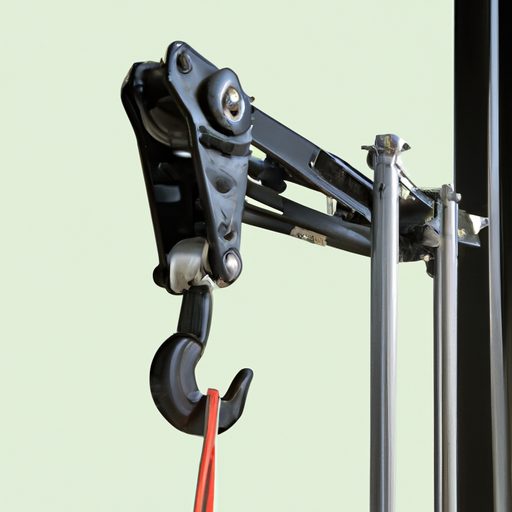
If you’re looking to enhance the functionality of your hoist system, there are a range of essential accessories and add-ons that can help you achieve just that. From remote controls and limit switches to load cells and adjustable trolleys, these accessories can greatly improve the efficiency and safety of your hoist system. By investing in the right add-ons, you can optimize your hoisting operations and ensure smooth and effective lifting in various industrial and commercial settings.
Types of Hoist Systems
Chain Hoists
Chain hoists are one of the most commonly used types of hoist systems. They consist of a metal chain that is wrapped around a pulley and connected to a hoist mechanism. These hoists are known for their durability and strength, making them suitable for lifting heavy loads in various industries. Chain hoists can be manually operated or powered by electricity, allowing for easy and efficient lifting operations.
Wire Rope Hoists
Wire rope hoists are another popular choice for hoist systems. Instead of a chain, these hoists use a wire rope that is wound around a drum and attached to a hoist mechanism. Wire rope hoists are known for their flexibility and versatility, allowing for smooth lifting and precise positioning of loads. They are often used in industries that require precise load control, such as manufacturing and construction.
Pneumatic Hoists
Pneumatic hoists operate using compressed air, making them an excellent choice for industries where electricity is not readily available or where the use of electricity is not safe. These hoists are powered by air pressure and can lift heavy loads with ease. Pneumatic hoists are often used in hazardous environments, such as oil refineries and chemical plants, where the presence of electricity can be dangerous.
Hydraulic Hoists
Hydraulic hoists use hydraulic pressure to lift and lower loads. They are commonly used in industries that require heavy lifting, such as construction and mining. Hydraulic hoists offer excellent power and control, allowing for precise load handling. They are also known for their stability and safety, making them a reliable choice for lifting heavy loads.
Lever Hoists
Lever hoists, also known as ratchet lever hoists, are manually operated hoists that use a lever mechanism to lift loads. These hoists are compact and portable, making them suitable for use in tight spaces or on job sites where mobility is essential. Lever hoists are known for their simplicity and ease of use, and they are often used in industries such as transportation and maintenance.
Lifting Attachments
Hooks
Hooks are essential lifting attachments that are used to securely connect the hoist to the load. They come in various sizes and configurations, allowing for easy attachment to different types of loads. Hooks are typically made of high-strength steel and are designed to withstand heavy loads without deformation or failure. They are a crucial component of any hoist system, providing a reliable connection between the hoist and the load.
Lifting Slings
Lifting slings are flexible straps or chains used to support and lift loads. They are available in various materials, such as nylon, polyester, and wire rope, and come in different configurations, including flat slings, round slings, and chain slings. Lifting slings provide a secure and stable support system for loads, allowing for safe and efficient lifting operations. They are often used in conjunction with hooks to ensure proper load handling.
Lifting Beams
Lifting beams are structural components that are used to distribute the weight of a load evenly. They are often used when lifting long or irregularly shaped loads that cannot be properly supported by hooks or slings alone. Lifting beams typically have multiple attachment points for hooks or slings, allowing for a balanced lifting operation. They are designed to provide stability and prevent damage to the load during lifting.
Clamps
Clamps are specialized lifting attachments that are used to securely grip and lift loads. They come in various types, such as plate clamps, beam clamps, and pipe clamps, and are designed to provide a high level of grip strength. Clamps are often used in industries where the load surface is smooth or where additional support is needed to prevent slippage. They are versatile attachments that can be easily adjusted to accommodate different load sizes and shapes.
Spreaders
Spreaders are lifting attachments used to spread the load over a larger area, increasing stability and reducing the risk of damage to the load. They are typically used when lifting wide or bulky loads that require additional support. Spreaders consist of two or more arms that extend outward from a central point and are connected to the lifting equipment. They are adjustable to accommodate different load sizes and provide a secure lifting operation.

Power Supply and Control Accessories
Power Supply Units
Power supply units, such as electric motors or pneumatic systems, provide the necessary power to operate the hoist system. They are available in various sizes and power capacities to meet the specific requirements of different hoist types. Power supply units are designed to deliver a consistent and reliable power source, ensuring smooth and efficient operation of the hoist system.
Speed Controllers
Speed controllers allow for precise control of the hoisting speed. They are often used in hoist systems that require slow and controlled lifting operations, such as in precision manufacturing or assembly lines. Speed controllers enable operators to adjust the lifting speed according to the specific load requirements and provide enhanced safety by preventing sudden or jerky movements.
Remote Control Systems
Remote control systems provide operators with the convenience of controlling the hoist system from a distance. They are often used in hoist systems that operate in hazardous or hard-to-reach areas, allowing operators to maintain a safe distance while still maintaining control over the lifting operation. Remote control systems can be wireless or wired, depending on the specific needs of the hoist system.
Push Button Stations
Push button stations are control devices that allow for easy and intuitive control of the hoist system. They are typically located near the hoist or at a convenient location for the operator. Push button stations are designed with large, easy-to-press buttons and provide simple and reliable control over the hoisting, lowering, and stopping functions of the hoist system.
Safety Accessories
Load Limiters
Load limiters are safety devices that prevent the hoist from lifting loads beyond its rated capacity. They are designed to monitor the load weight and automatically stop the lifting operation if the load exceeds the safe working limit. Load limiters provide an added layer of protection against overloading, ensuring the safety of both the operator and the hoist system.
Emergency Stop Buttons
Emergency stop buttons are essential safety devices that allow for immediate and complete shut-off of the hoist system in emergency situations. They are strategically placed within easy reach of the operator and can be quickly pressed to stop all hoist operations. Emergency stop buttons provide a reliable and effective means of stopping the hoist system in case of a malfunction or any other hazardous situation.
Locking Devices
Locking devices are used to secure the load in place during lifting operations. They prevent accidental release of the load and provide added stability and safety during transportation or storage. Locking devices come in various types, including latch kits, locking pins, and locking hooks, and are designed to securely fasten the load to the lifting attachment or hoist system.
Safety Latches
Safety latches are devices that prevent the accidental disengagement of the load from the hook. They are attached to the hook and provide an additional point of contact to keep the load securely in place. Safety latches are typically spring-loaded and automatically engage when the load is lifted, providing a reliable and secure connection between the hook and the load.

Hoist Trolleys and Runways
Push Trolleys
Push trolleys are manually operated devices that allow for horizontal movement of the hoist along a beam or track. They are designed to be easily pushed or pulled by the operator, providing mobility and flexibility in the lifting operation. Push trolleys are often used in applications where frequent repositioning of the hoist is required, such as in assembly lines or warehouses.
Geared Trolleys
Geared trolleys are similar to push trolleys but feature gears or worm drives that provide additional lifting and positioning control. They are often used in hoist systems that require more precise load handling or in applications where heavy loads need to be lifted with ease. Geared trolleys allow for smooth and controlled movement of the hoist along the beam or track.
Motorized Trolleys
Motorized trolleys are power-driven devices that eliminate the need for manual pushing or pulling of the hoist. They are often used in hoist systems with heavy loads or in applications where frequent movement of the hoist is required. Motorized trolleys provide enhanced efficiency and ease of use, allowing operators to focus on other tasks while the hoist is in motion.
Runway Beams
Runway beams are structural components that provide a secure and stable track for the hoist system. They are typically installed overhead and support the weight of the hoist and the load. Runway beams are made of durable materials, such as steel, and are designed to withstand heavy loads and constant use. They play a critical role in the safe and efficient operation of the hoist system.
Maintenance Accessories
Cleaning Supplies
Cleaning supplies are essential for maintaining the cleanliness and proper functioning of the hoist system. They include various cleaning agents, brushes, and tools that are used to remove dirt, grease, and other contaminants from the hoist components. Regular cleaning helps prevent corrosion, extends the lifespan of the hoist system, and ensures reliable operation.
Lubricants
Lubricants are used to reduce friction between moving parts of the hoist system, ensuring smooth and efficient operation. They help prevent wear and tear, reduce noise, and minimize the risk of breakdowns or malfunctions. Lubricants come in various forms, such as oils, greases, and sprays, and are applied to the hoist components according to the manufacturer’s recommendations.
Hoist Covers
Hoist covers are protective accessories that shield the hoist system from dust, dirt, and other environmental factors. They provide an added layer of protection against corrosion and damage, helping to prolong the lifespan of the hoist system. Hoist covers are typically made of durable materials, such as vinyl or canvas, and are designed to fit snugly over the hoist components.
Replacement Parts
Replacement parts are essential for the maintenance and repair of the hoist system. They include components such as hooks, slings, chains, cables, and electrical parts that may wear out or break over time. Having a stock of replacement parts ensures quick and efficient repairs, minimizing downtime and ensuring the continuous operation of the hoist system.

Enhanced Performance Add-Ons
Two-speed Hoisting
Two-speed hoisting systems allow for the lifting of loads at different speeds. They provide operators with the option to switch between a high-speed mode for faster lifting and a low-speed mode for more precise load handling. Two-speed hoisting systems are often used in applications where different loads require different lifting speeds, allowing for increased efficiency and productivity.
Variable Frequency Drives
Variable frequency drives (VFDs) are electronic devices that control the speed and torque of electric motors. They allow operators to adjust the motor speed according to the specific load requirements, providing enhanced control and energy efficiency. VFDs are often used in hoist systems that require precise load control or in applications where energy conservation is a priority.
Loading Unloading Assistants
Loading and unloading assistants, such as load cells or weighing systems, provide operators with real-time feedback on the load weight. They help ensure that the hoist system operates within its safe working limit and prevents overloading. Loading and unloading assistants are particularly useful in industries where accurate load measurement is critical, such as in shipping and logistics.
Braking Systems
Electric Braking Systems
Electric braking systems are used to control the hoist’s stopping and holding capabilities. They provide precise and responsive braking, ensuring the load remains stable and secure during lifting and lowering operations. Electric braking systems are often used in hoist systems that require frequent starts and stops or where precise load positioning is necessary.
Mechanical Braking Systems
Mechanical braking systems, such as disc brakes or shoe brakes, provide reliable stopping and holding power for hoist systems. They are typically operated mechanically and are designed to withstand heavy loads and frequent use. Mechanical braking systems offer excellent durability and reliability, making them a popular choice in various industries.
Hydraulic Braking Systems
Hydraulic braking systems use hydraulic pressure to control the braking action of the hoist system. They provide strong, reliable, and consistent braking power, ensuring safe and controlled stopping of the hoist. Hydraulic braking systems are often used in hoist systems that require quick and precise braking or in applications where electric braking may not be suitable.

Noise Reduction Solutions
Silencers
Silencers, also known as noise suppressors or mufflers, are devices used to reduce the noise generated by the hoist system. They are typically installed on the exhaust or intake ports of pneumatic or hydraulic components and help dampen the sound waves produced during operation. Silencers improve the work environment by reducing noise pollution and protecting the hearing of operators.
Sound Absorbing Materials
Sound absorbing materials, such as acoustic foam or curtains, are used to absorb and reduce noise reflections in the working area. They are typically installed on walls, ceilings, or other surfaces to minimize noise reverberation and create a quieter work environment. Sound absorbing materials help improve productivity by reducing noise distractions and creating a more comfortable atmosphere for operators.
Vibration Dampers
Vibration dampers are devices used to reduce the vibrations produced by the hoist system during operation. They are typically made of rubber or other elastomeric materials and are installed between the hoist components and the supporting structure. Vibration dampers help minimize vibrations that can cause noise and fatigue, ensuring a smoother and quieter operation.
Fitment Options for Noise Reduction
Hoist systems can be equipped with various fitment options to further reduce noise levels. These options may include enclosures or soundproof housings that contain the hoist components and dampen the noise generated during operation. Fitment options for noise reduction are particularly beneficial in noise-sensitive environments, such as hospitals or residential areas.
Custom Add-Ons and Modifications
Custom Control Systems
Custom control systems are designed to meet specific requirements or to integrate the hoist system with other equipment or processes. They can include programmable logic controllers (PLCs), remote monitoring systems, or specialized control interfaces. Custom control systems offer enhanced functionality and flexibility, allowing for seamless integration and improved overall performance.
Custom Trolley Configurations
Custom trolley configurations are designed to fit specific beam widths, load capacities, or lifting requirements. They can include modifications such as extended wheels, adjustable spans, or specialized locking mechanisms. Custom trolley configurations ensure optimal load handling and smooth movement along the beam or track, enhancing the efficiency and versatility of the hoist system.
Custom Lifting Attachments
Custom lifting attachments are specially designed to lift unique or non-standard loads. They can include modifications such as specialized hooks, adjustable arms, or customized grip surfaces. Custom lifting attachments ensure safe and secure lifting of unconventional loads, expanding the capabilities of the hoist system and enabling efficient handling of a wide range of objects.
Material Specific Modifications
Material specific modifications are made to the hoist system to optimize its performance for specific load materials. These modifications may include special coatings, liners, or grips that enhance the hoist’s ability to handle particular materials, such as fragile or slippery objects. Material specific modifications ensure safe and efficient lifting of specific loads, minimizing the risk of damage or accidents.
Other Customer-Specific Add-Ons
Hoist systems can be customized with other customer-specific add-ons to meet unique needs or specific industry requirements. These add-ons can include additional safety features, specialized control interfaces, or integration with other equipment or systems. Other customer-specific add-ons provide customized solutions to enhance the functionality and performance of the hoist system, ensuring optimal operation in any given application.
In conclusion, there are various essential accessories and add-ons available that can greatly improve the functionality of a hoist system. From different types of hoist systems to lifting attachments, power supply and control accessories, safety accessories, hoist trolleys and runways, maintenance accessories, enhanced performance add-ons, braking systems, noise reduction solutions, and custom add-ons and modifications, each component plays a crucial role in optimizing the performance, safety, and efficiency of the hoist system. By carefully selecting and incorporating the right combination of accessories and add-ons, operators can customize their hoist system to meet their specific lifting requirements and achieve optimal results in their respective industries.










